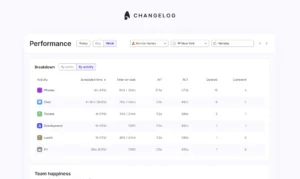
Measuring the return on investment of scheduling software

When trying to scale, customer support teams usually transition away from spreadsheets or free software. To justify the move from something free to a specialised but paid scheduling software, it’s important to estimate and understand the ROI (return on investment). This is critical when convincing your team and other stakeholders of the value it can create.
In a macro-environment filled with cost pressures and budget cuts, improving efficiency has become the most important metric for teams. For support teams, software can often be used as a way of improving efficiency in a cost-effective way.
Reduce the amount of time spent forecasting and planning
Time is money, and the more time your team spends on forecasting, scheduling or planning, the more time you need to waste on planning.
Whether you have a full-time WFM (workforce management) team or scheduling is split across support team managers, we typically see a ratio of twenty hours spent on forecasting and scheduling per week per 15 employees. This increases if you offer varying shift patterns and your team works across different timezones, tasks or activities within a single day.
With scheduling software, a team of 40 customer support agents can save resource bandwidth equivalent to almost one full-time person with a fully loaded* cost of £52,000. This saved time can be used to optimise resources and increase productivity.
An improvement in productivity
A lack of effective scheduling results in not having the right number of people working on the right things. This might mean that when phones are busy, you have team members working on admin tasks or project work, artificially increasing the required bandwidth you need in your team. Ineffective planning might also mean you don’t schedule sufficient time for your team to train or improve, reducing productivity.
When teams schedule on spreadsheets, they gravitate towards the path of least resistance and often have the same people work on the same tasks to avoid creating new templates. This results in burnout causing high attrition and high absenteeism.
With Surfboard, we typically see a 12.5% productivity uplift when a support team adopts scheduling software. For an illustrative team of 40 customer support members, this results in a fully loaded* cost saving of £200,000.
Better multi-location team management
With remote and hybrid working, support teams can save money and make work more human by leveraging globally distributed teams, including part-time workers. This reduces the complexity of requiring antisocial shifts by offering a “follow the sun” working model. It also reduces the need for overtime costs and means organisations can benefit from cost arbitrage across different geographies.
For a support team of 40, this can result in an additional saving of £140,000.
*fully loaded includes national insurance, pension and related employment costs
Cost pressures or budget constraints don’t mean stopping investment in tooling.
A cost reduction or spending review doesn’t mean ceasing spend on scheduling software or tooling. The right way to do this is to assess the return on investment of any software you use. Even for a small team, the return on investment of scheduling software is near immediate. This is because it’s easy to measure the human hours and opportunity costs, which would otherwise be incurred without scheduling software.
To learn more about how scheduling software can positively impact your ROI, get in touch with us today.



